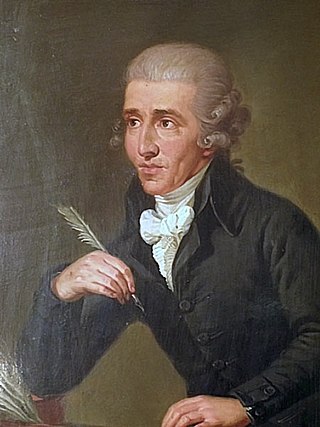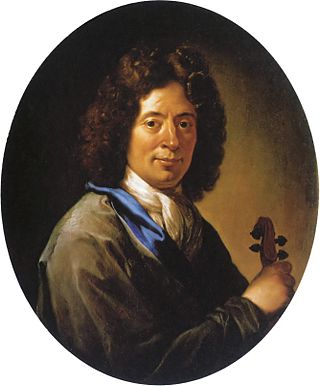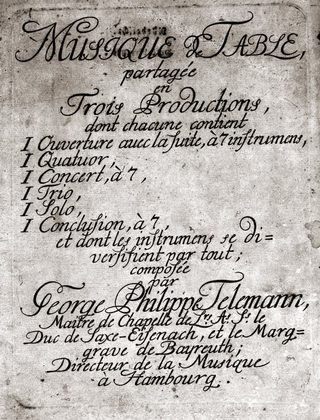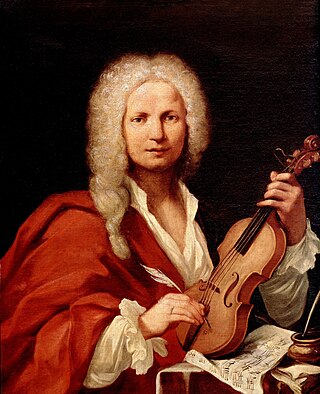Related Research Articles
The concerto grosso is a form of baroque music in which the musical material is passed between a small group of soloists and full orchestra. This is in contrast to the solo concerto which features a single solo instrument with the melody line, accompanied by the orchestra.

The Brandenburg Concertos by Johann Sebastian Bach are a collection of six instrumental works presented by Bach to Christian Ludwig, Margrave of Brandenburg-Schwedt, in 1721. The original French title is Six Concerts Avec plusieurs instruments, meaning "Six Concertos for several instruments". Some of the pieces feature several solo instruments in combination. They are widely regarded as some of the greatest orchestral compositions of the Baroque era.
The year 1715 in music involved some significant events.

The Cello Concerto No. 1 in C major, Hob. VIIb/1, by Joseph Haydn was composed around 1761-65 for longtime friend Joseph Franz Weigl, then the principal cellist of Prince Nicolaus's Esterházy Orchestra.

Twelve concerti grossi, Op. 6, is a collection of twelve concerti written by Arcangelo Corelli probably in the 1680s but not prepared for publication until 1714. They are among the finest and first examples of concerti grossi: concertos for a concertino group and a ripieno group of strings with continuo. Their publication – decades after their composition and after Italian composers had moved to favor the ritornello concerto form associated with Vivaldi – caused waves of concerto grosso writing in Germany and England, where in 1739 George Frideric Handel honored Corelli directly with his own "Opus 6" collection of twelve.

Concerto grosso in G minor, Op. 6, No. 8 by Arcangelo Corelli, known commonly as the Christmas Concerto, was commissioned by Cardinal Pietro Ottoboni and published posthumously in 1714 as part of Corelli's Twelve concerti grossi, Op. 6. The concerto bears the inscription Fatto per la notte di Natale. Its composition date is uncertain, but there is a record of Corelli having performed a Christmas concerto in 1690 for the enjoyment of his new patron.
The Oboe Concerto in D minor, S D935, is an early 18th-century concerto for oboe, strings and continuo attributed to the Venetian composer Alessandro Marcello. The earliest extant manuscript containing Johann Sebastian Bach's solo keyboard arrangement of the concerto, BWV 974, dates from around 1715. As a concerto for oboe, strings and continuo its oldest extant sources date from 1717: that year it was printed in Amsterdam, and a C minor variant of the concerto, S Z799, was written down.
An organ concerto is an orchestral piece of music in which a pipe organ soloist is accompanied by an an orchestra, although some works exist with the name "concerto" which are for organ alone.

Johann Ernst of Saxe-Weimar was a German prince, son by his second marriage of Johann Ernst III, Duke of Saxe-Weimar. Despite his early death he is remembered as a collector and commissioner of music and as a composer, some of whose concertos were arranged for harpsichord or organ by Johann Sebastian Bach, who was court organist in Weimar at the time.

The Twelve Grand Concertos, Op. 6, HWV 319–330, by George Frideric Handel are concerti grossi for a concertino trio of two violins and cello and a ripieno four-part string orchestra with harpsichord continuo. First published by subscription in London by John Walsh in 1739, they became in a second edition two years later Handel's Opus 6. Taking the older concerto da chiesa and concerto da camera of Arcangelo Corelli as models, rather than the later three-movement Venetian concerto of Antonio Vivaldi favoured by Johann Sebastian Bach, they were written to be played during performances of Handel's oratorios and odes. Despite the conventional model, Handel incorporated in the movements the full range of his compositional styles, including trio sonatas, operatic arias, French overtures, Italian sinfonias, airs, fugues, themes and variations and a variety of dances. The concertos were largely composed of new material: they are amongst the finest examples in the genre of baroque concerto grosso.
The Musette, or rather chaconne, in this Concerto, was always in favour with the composer himself, as well as the public; for I well remember that HANDEL frequently introduced it between the parts of his Oratorios, both before and after publication. Indeed no instrumental composition that I have ever heard during the long favour of this, seemed to me more grateful and pleasing, particularly, in subject.

Rococo Á Go Go is the fifth album released by the Swingle Singers. The album was nominated for a 1966 Grammy award.

The Concerti grossi, Op. 3, HWV 312–317, are six concerti grossi by George Frideric Handel compiled into a set and published by John Walsh in 1734. Musicologists now agree that Handel had no initial knowledge of the publishing. Instead, Walsh, seeking to take advantage of the commercial success of Corelli's Concerti grossi, Op. 6, simply combined several of Handel's already existing works and grouped them into six "concertos".

Concerto grosso in D major, Op. 6, No. 4, is a composition by Arcangelo Corelli, and was published as the fourth concerto in his Twelve Concerti Grossi, Op. 6 in 1714. This concerto grosso is the second most notable of the twelve, after No. 8, the famous Christmas Concerto. No. 4 is mainly notable for its overall joyfully charged sound, making it a frequently used example when demonstrating Corelli's renowned cantabile style.

Tafelmusik is a collection of instrumental compositions by Georg Philipp Telemann (1681–1767), published in 1733. The original title is Musique de table. The work is one of Telemann's most widely known compositions; it is the climax and at the same time one of the last examples of courtly table music.

Grosso mogul, also Il grosso mogul, or capitalised [Il] Grosso Mogul, RV 208, is a violin concerto in D major by Antonio Vivaldi. The concerto, in three movements, is an early work by the Venetian composer. Around the mid-1710s Johann Sebastian Bach transcribed the concerto for organ, BWV 594, in C major. A simplified version of the violin concerto, RV 208a, without the elaborated cadenzas that appear in manuscript versions of RV 208, and with a different middle movement, was published around 1720 in Amsterdam as concerto #11 of Vivaldi's Op. 7.

Stabat Mater by Alessandro Scarlatti is a religious musical work composed for two voices (soprano/alto), two violins and basso continuo, in 1724, on a commission from the Order of Friars Minor, the "Knights of the Virgin of Sorrows" of the Church of San Luigi in Naples for Lent
References
- 1 2 Filiatrault 2010, p. 11.
- ↑ Dent 1905, p. 173.
- ↑ Filiatrault 2010, p. 9.
- 1 2 Filiatrault 2010, p. 10.
- 1 2 Dent 1905, p. 174.
- ↑ Lattanzi 2014, p. 7.
- ↑ London, British Library (GB-Lbl) Ms. R.M.21.b.14. Le manuscrit R.M.21.b.15, contient les parties séparées.
- ↑ RISM 800247279 Concerto 1 de GB-Lbl Ms. R.M.21.b.14 on RISM
- ↑ RISM 800247280 Concerto 2 de GB-Lbl Ms. R.M.21.b.14 on RISM
- ↑ RISM 800247281 Concerto 3 de GB-Lbl Ms. R.M.21.b.14 on RISM
- ↑ RISM 800247282 Concerto 4 de GB-Lbl Ms. R.M.21.b.14 on RISM
- ↑ RISM 800247283 Concerto 5 de GB-Lbl Ms. R.M.21.b.14 on RISM
- ↑ RISM 800247284 Concerto 6 de GB-Lbl Ms. R.M.21.b.14 on RISM
- ↑ RISM 800247285 Concerto 7 de GB-Lbl Ms. R.M.21.b.14 on RISM
- ↑ RISM 800247286 Concerto 8 de GB-Lbl Ms. R.M.21.b.14 on RISM
- ↑ RISM 800247287 Concerto 9 de GB-Lbl Ms. R.M.21.b.14 on RISM
- ↑ RISM 800247288 Concerto 10 de GB-Lbl Ms. R.M.21.b.14 on RISM
- ↑ RISM 800247289 Concerto 11 de GB-Lbl Ms. R.M.21.b.14 on RISM
- ↑ RISM 800247290 Concerto 12 de GB-Lbl Ms. R.M.21.b.14 on RISM
- ↑ Johan van Veen (November 2015). "Review — Alessandro Scarlatti, 12 Sinfonie di concerto grosso". musicweb-international.com.